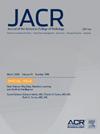Missed Screening Mammography Appointments: Patient Sociodemographic Characteristics and Mammography Completion After 1 Year
IF 4
3区 医学
Q1 RADIOLOGY, NUCLEAR MEDICINE & MEDICAL IMAGING
引用次数: 0
Abstract
Objective
Patients who miss screening mammogram appointments without notifying the health care system (no-show) risk care delays. We investigate sociodemographic characteristics of patients who experience screening mammogram no-shows at a community health center and whether and when the missed examinations are completed.
Methods
We included patients with screening mammogram appointments at a community health center between January 1, 2021, and December 31, 2021. Language, race, ethnicity, insurance type, residential ZIP code tabulation area (ZCTA) poverty, appointment outcome (no-show, same-day cancelation, completed), and dates of completed screening mammograms after no-show appointments with ≥1-year follow-up were collected. Multivariable analyses were used to assess associations between patient characteristics and appointment outcomes.
Results
Of 6,159 patients, 12.1% (743 of 6,159) experienced no-shows. The no-show group differed from the completed group by language, race and ethnicity, insurance type, and poverty level (all P < .05). Patients with no-shows more often had: primary language other than English (32.0% [238 of 743] versus 26.7% [1,265 of 4,741]), race and ethnicity other than White non-Hispanic (42.3% [314 of 743] versus 33.6% [1,595 of 4,742]), Medicaid or means-tested insurance (62.0% [461 of 743] versus 34.4% [1,629 of 4,742]), and residential ZCTAs with ≥20% poverty (19.5% [145 of 743] versus 14.1% [670 of 4,742]). Independent predictors of no-shows were Black non-Hispanic race and ethnicity (adjusted odds ratio [aOR], 1.52; 95% confidence interval [CI], 1.12-2.07; P = .007), Medicaid or other means-tested insurance (aOR, 2.75; 95% CI, 2.29-3.30; P < .001), and ZCTAs with ≥20% poverty (aOR, 1.76; 95% CI, 1.14-2.72; P = .011). At 1-year follow-up, 40.6% (302 of 743) of patients with no-shows had not completed screening mammogram.
Discussion
Screening mammogram no-shows is a health equity issue in which socio-economically disadvantaged and racially and ethnically minoritized patients are more likely to experience missed appointments and continued delays in screening mammogram completion.
错过乳腺 X 射线造影筛查预约:患者的社会人口学特征和一年后完成乳腺 X 射线造影检查的情况。
目标未通知医疗保健系统而错过乳腺 X 线照相筛查预约(未预约)的患者有可能延误治疗。我们调查了社区卫生中心乳腺 X 光筛查缺席患者的社会人口学特征,以及缺席的检查是否和何时完成。方法我们纳入了 2021 年 1 月 1 日至 2021 年 12 月 31 日期间在社区卫生中心预约乳腺 X 光筛查的患者。我们收集了语言、种族、民族、保险类型、居住地邮政编码表区(ZCTA)贫困程度、预约结果(未预约、当天取消预约、已完成预约)以及未预约后完成乳腺 X 光筛查的日期,并进行了≥1 年的随访。结果 在 6,159 名患者中,12.1%(6,159 人中的 743 人)的患者没有预约。未赴约组与已赴约组在语言、种族和民族、保险类型和贫困程度方面存在差异(所有 P 均为 0.05)。未就诊患者的主要语言多为非英语(32.0% [743 人中的 238 人] 与 26.7% [4,741 人中的 1,265 人]),种族和族裔多为非西班牙裔白人(42.3% [743 人中的 314 人] 与 33.6% [4,741 人中的 1,595 人])。6%[4,742人中的1,595人])、医疗补助或经济情况调查保险(62.0%[743人中的461人]对34.4%[4,742人中的1,629人])以及贫困率≥20%的居住区(19.5%[743人中的145人]对14.1%[4,742人中的670人])。非西班牙裔黑人种族和民族(调整赔率比 [aOR],1.52;95% 置信区间 [CI],1.12-2.07;P = .007)、医疗补助计划或其他经济情况调查保险(aOR,2.75;95% 置信区间,2.29-3.30;P <.001)以及贫困率≥20% 的 ZCTAs(aOR,1.76;95% 置信区间,1.14-2.72;P = .011)是不就诊的独立预测因素。讨论乳房 X 光筛查缺席是一个健康公平问题,社会经济状况不佳、种族和民族少数的患者更有可能错过预约,并继续推迟完成乳房 X 光筛查。
本文章由计算机程序翻译,如有差异,请以英文原文为准。
求助全文
约1分钟内获得全文
求助全文
来源期刊

Journal of the American College of Radiology
RADIOLOGY, NUCLEAR MEDICINE & MEDICAL IMAGING-
CiteScore
6.30
自引率
8.90%
发文量
312
审稿时长
34 days
期刊介绍:
The official journal of the American College of Radiology, JACR informs its readers of timely, pertinent, and important topics affecting the practice of diagnostic radiologists, interventional radiologists, medical physicists, and radiation oncologists. In so doing, JACR improves their practices and helps optimize their role in the health care system. By providing a forum for informative, well-written articles on health policy, clinical practice, practice management, data science, and education, JACR engages readers in a dialogue that ultimately benefits patient care.
 求助内容:
求助内容: 应助结果提醒方式:
应助结果提醒方式:


